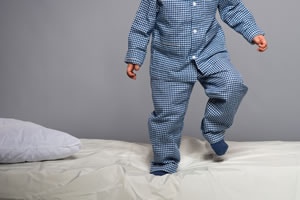Sleepwalking is a common form of parasomnia (a category of sleep disorders that involve abnormal behaviours during sleep) affecting both children and adults. It occurs when the affected person arises out of the slow-wave sleep cycle and performs actions commonly associated with being awake, without fully regaining consciousness. While the most obvious symptom is walking around while still sleeping, there are many actions that can take place while the person is unaware of committing them.
The individual can simply sit up awake in bed, act out inappropriate behaviours like urinating in the closet, they may lash out verbally or with violence, some people eat while sleepwalking, or in extreme cases get behind the wheel of a car and drive long distances. The person’s eyes are usually open and glassy, and if spoken to they may respond slowly or not at all. The sleepwalker may have some memory of what happened, but most of the time they have no recollection at all of what they did while asleep. Sleepwalking is more common in children then adults, and can present itself in children as early as 3 years-old.
Sign Up For Our Newsletter
Sleepwalking occurs within an hour or two of falling asleep during the deep phase of sleep. We sleep in 90-100 minute sleep cycles, which consist of 4 stages of sleep. We complete 5 to 6 cycles of sleep per night. Sleepwalking tends to occur during the first or second sleep cycle during stage 3 of sleep. This transitional period between active and quiet sleep is where you become less responsive to noises and activities around you.
Why Does Someone Sleepwalk?
Depending on age, there are several reasons why sleepwalking occurs. Genetics play a role, and if there is a history of sleepwalking in your family there is a 10 percent chance that your child may experience episodes of sleepwalking as well. Sleepwalking can be a very normal occurrence in a child’s typically developing sleep patterns and it’s usually nothing to worry about. If your child suffers from sleep apnea or is a chronic bed wetter, there is a higher chance they could sleepwalk. The following triggers could also cause the disorder:
- Sleep deprivation
- Following an inconsistent sleep schedule
- Intoxication
- Taking certain medications (sedatives, neuroleptics, and antihistamines)
- Stress
- Medical conditions (Including: magnesium deficiency, fever, sleep apnea, abnormal heart rhythms, nighttime asthma, pregnancy or menstruation)
Typically children grow out of sleepwalking. Sleepwalking is a common occurrence and generally there is no cause for medical or emotional concern but it’s always best to speak to a professional for possible further tests on yourself or your child.
How You Can Help
While there is no treatment for sleepwalking there are steps parents can take for themselves and their child. A family’s best bet to avoid sleepwalking episodes is to follow proper sleep hygiene within their home:
- Sleep deprivation is the number one cause for most sleep disturbances. Make sure that each family member is regularly logging his or her age appropriate quantity of sleep.
- Follow a consistent sleep schedule to make sure that each family member is receiving the proper quality of restorative sleep as well.
- If you have a history of sleepwalking avoid going to bed after consuming alcohol and speak to your doctor about the medications you are taking.
- Incorporate a relaxing bedtime routine for yourself and your child.
- Create an environment conducive to sleep for the whole family.
- Use meditation or yoga to lower stress levels.
Sleepwalking Myth!
Most have heard that you should never wake a sleepwalker but you can if necessary. Because they are in such a deep state of sleep they’ll likely appear groggy and disoriented and may not remember anything in the morning. If waking the child or individual is necessary do so calmly and gently or just quietly lead them back to bed.
Is Sleepwalking Harmful?
The disorder itself isn’t dangerous it’s important to make sure that the person suffering this sleep disturbance is safe.
- A child’s room should be safety proofed, bunk beds should be avoided, and dangerous objects should be made secure. Install gates for the stairways if necessary.
- Make sure all windows and doors are locked. Think about potentially installing combination locks if necessary.
- Hide car keys from teens or adults if sleepwalking is a concern.
- Install bells on bedroom doors to make sure the parent or spouse is signaled to be woken up if the sleepwalker exits the bedroom.
Sleepwalking is most often a phase that is grown out of, but even if it continues into adulthood, it is manageable – often with lifestyle changes or with prescription medications. Melatonin supplements do not help with sleepwalking and can actually be a trigger for sleepwalking.
This article was previously posted on Yummy Mummy Club.

Alanna McGinn is a Certified Sleep Consultant and Founder of Good Night Sleep Site – a Global Pediatric and Family Sleep Team. She provides free child and family sleep support through Facebook, Twitter, and Instagram. She invites you to join her sleep community as she works towards Good Night Sleep Site’s mission of a healthier rested family unit. For more sleep tips, subscribe to our newsletter and visit Good Night Sleep Site.











